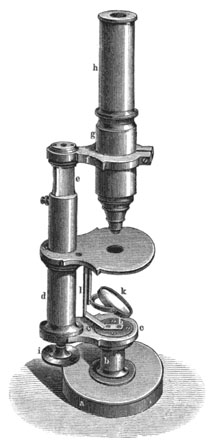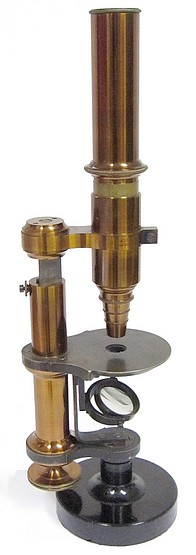


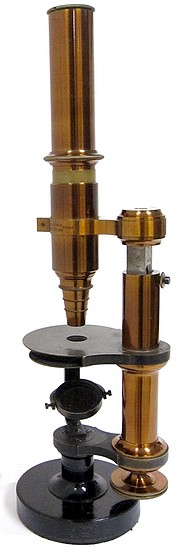
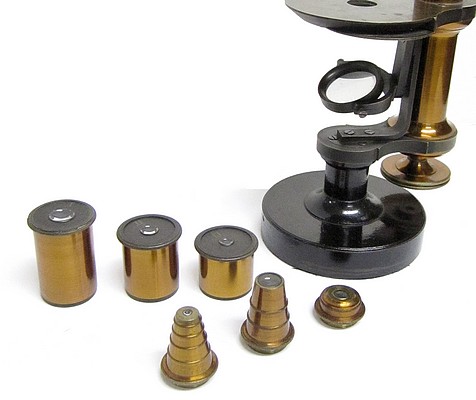
The microscope is equipped with three eyepieces numbered I, II, and III and three signed objectives numbered 0, 1, and 3. The microscope is capable of full rotation along the optical axis with the mirror remaining stationary. In the 1866 price list, this model is referred to as the "Kleines Mikroskop". It is 12.25 inches tall as shown in the figure. The round iron base is painted black and is 3 and 3/8 inches in diameter. A short iron pillar rises from the base and engages a short oxidized brass arm that supports the main body of the microscope. This arm can freely rotate about the base so that the microscope is capable of full 360° rotation. The single sided concave mirror is attached to a arm with a swivel joint that allows lateral side to side movement of the mirror. The coarse adjustment is by push tube. The outer tube is sprung and contains an adjustment screw that allows the tension to be altered. The fine adjustment utilizes a micrometer screw located under the pillar. The round stage has an oxidized brass finish. There is no provision for stage clips. Inset under the stage is a wheel with five apertures.
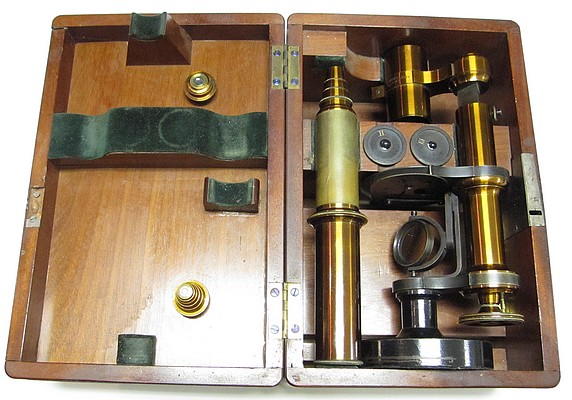
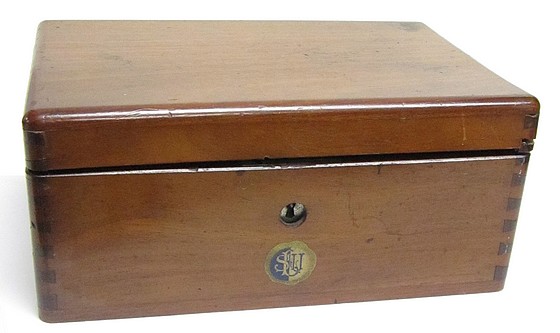
In 1849, Carl Kellner founded what was named the Optical Institute in Wetzlar Germany. By 1851 he employed twelve workmen and was producing his first microscopes. Kellner's microscopes met with wide acclaim and were furnished with his noted invention, the orthoscopic eyepiece. Unfortunately, at only the age of twenty nine, Kellner succumbed to tuberculosis in 1855. The Optical Institute survived under the leadership of Friedrich Belthle, an apprentice of Kellner's, who married Kellner's widow shortly after his death. In 1863 Ernst Leitz joined the Institute. By 1865 he was a partner in the firm, and later became the sole proprietor after Belthle's death in 1869.
This is an example of the small sized model 3a produced by the firm. See: Fr. Belthle, Nachfolger von C. Kellner, in Wetzlar - Price list for 1866. Represented in this collection is another example of this model having a different selection of optics and a different layout within the wood storage case.
For more information about these early Wetzlar microscopes see the article: Some Early Microscopes from the Optical Institute in Wetzlar
A search of the
production archives retained by Leica Microsystems
GmbH of microscopes made in the early period of the
Optical Institute in Wetzlar indicates that this
Belthle microscope with serial number 829 is Stand
3 and was delivered to Friedrich Kempf in
Meissenheim on April 21, 1866. It cost 50
Thaler.
At some point in its
history, this microscope had made its way into the
United States of America. It was purchased for this
collection in the US and found within the case was
an old prescription written by a
Dr. E. G. Merwin mentioning Philibert's Pharmacy,
which was located in St. Louis MO. In addition, the
outside of the case bears a round label with the
initials SLU (St. Louis University)
There was a Friedrich Kempf born in Meisenheim, Hessen, Germany on 11 Mar 1844. He died on 24 Oct 1930 in Highland, Madison, Illinois (located right across the river is the SLU campus). Most likely, he is the person who originally purchased this microscope.
(I thank Dr. Timo Mappes and Rolf Beck of Leica Microsystems GmbH for their help in obtaining information from the early archives of the firm)
